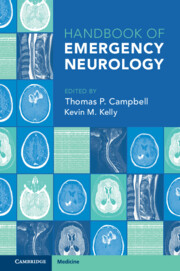Book contents
- Handbook of Emergency Neurology
- Handbook of Emergency Neurology
- Copyright page
- Contents
- Contributors
- Section 1 Neurologic Examination and Neurodiagnostic Testing
- Chapter 1 Emergency Neurologic Examination
- Chapter 2 Neuroradiology
- Chapter 3 Electroencephalography
- Chapter 4 Lumbar Puncture
- Section 2 Common Neurologic Presentations: A Symptom-Based Approach
- Section 3 Specific Neurological Disorders in Emergency Medicine
- Index
- References
Chapter 2 - Neuroradiology
from Section 1 - Neurologic Examination and Neurodiagnostic Testing
Published online by Cambridge University Press: 10 January 2024
- Handbook of Emergency Neurology
- Handbook of Emergency Neurology
- Copyright page
- Contents
- Contributors
- Section 1 Neurologic Examination and Neurodiagnostic Testing
- Chapter 1 Emergency Neurologic Examination
- Chapter 2 Neuroradiology
- Chapter 3 Electroencephalography
- Chapter 4 Lumbar Puncture
- Section 2 Common Neurologic Presentations: A Symptom-Based Approach
- Section 3 Specific Neurological Disorders in Emergency Medicine
- Index
- References
Summary
Nearly half of all emergency department (ED) visits in the United States result in some type of imaging study, a large number of which are performed for neurological complaints. Common presenting neurological complaints include headache, weakness, stroke, and trauma. Often the initial study performed for the evaluation of these complaints is an unenhanced computed tomography (CT) of the brain. However, as will be discussed below, certain presentations and clinical history can warrant magnetic resonance imaging (MRI) as a superior first-line imaging test. This chapter seeks to provide guidance in imaging modality selection and to discuss imaging findings in common clinical presentations to the ED. When pertinent, alternative and recommended follow-up studies are also discussed
Keywords
- Type
- Chapter
- Information
- Handbook of Emergency Neurology , pp. 8 - 35Publisher: Cambridge University PressPrint publication year: 2023

